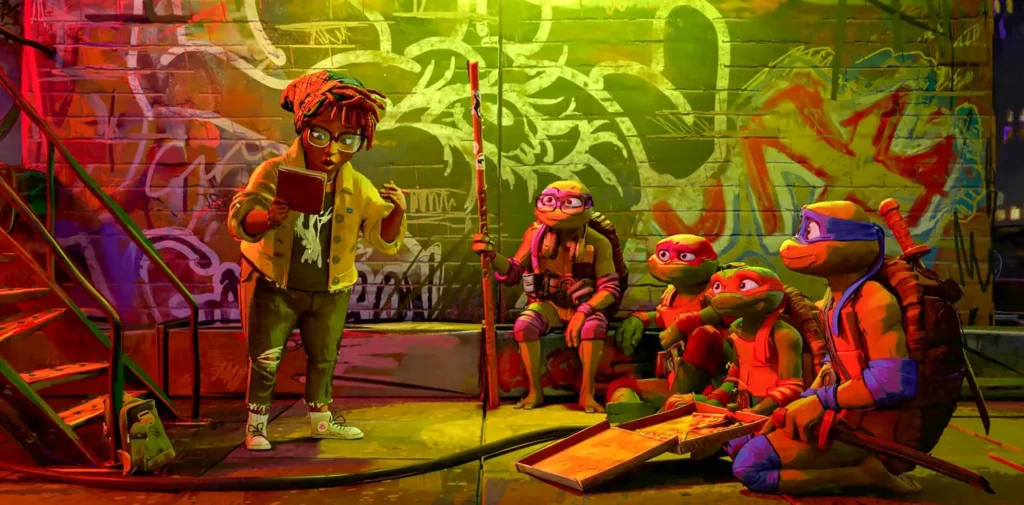Teenage Mutant Ninja Turtles held a special place in my heart during my childhood years. I found immense joy in tuning in to the animated escapades of Leonardo, Michaelangelo, Donatello and Raphael whenever they graced our television screen. Their courageous battles against the malevolent Foot Clan captivated me. Each encounter saw them triumph over the intimidating antagonist, Shredder, who was more fearsome-looking than necessary. And when Bebop and Rocksteady entered the scene, their imposing size and formidable strength presented an undeniable threat, even without strategic intelligence.
The animated series meant more to me than just entertainment; it became a passion. In fact, it ignited my curiosity about karate. At the tender age of 10, my parents enrolled me in Keith Goolsby’s United Karate Studio. Conveniently nestled in the back room of the nearby skating rink, the studio sat just across the street from my home. Over the next few years, I progressed from a novice white belt to a proficient purple belt. In contrast to Master Splinter’s teachings, my training emphasized the responsible use of martial skills exclusively for aiding those in need, rather than wielding weapons.
My days were filled with mastering various forms, attempting to achieve splits (failed), and engaging in sparring sessions with fellow students, all while adorned in somewhat awkward foam padding. It might not have been glamorous, yet every moment was exhilarating, and I relished the experience.
The new film, Teenage Mutant Ninja Turtles: Mutant Mayhem, is a modern reboot of the franchise. In this retelling, Baxter Stockman (Giancarlo Esposito), a scientist working on a mutagenic ooze, is targeted by his former employer, TCRI, in an attempt to recover his research. During the scuffle, the TCRI agents kill Stockman, but the ooze, as well as one of his experiments (a housefly), are lost.
But as we know, the ooze covered four baby turtles and a rat who discovered them, turning them into human/animal hybrids.
Fifteen years later, the four turtle siblings yearn for life outside the confines of the New York City sewers they call home. Due to his mistrust of the human world, Splinter (Jackie Chan), their rat dad, refuses to allow them to interact with humans, having them go on covert missions to retrieve items such as toilet paper and Doritos.
One fateful night, the turtles encounter a young human named April (Ayo Edebiri), and after recovering her stolen scooter, befriend her. Between them, they come up with a plan to turn the four brothers into heroes, by stopping the thefts throughout the city by a gang led by a secretive villain named Superfly (Ice Cube).
Their plan is put to the test when they discover Superfly is the mutated housefly that lived with Baxter Stockman, as well as his gang being all mutants themselves, including Mondo Gecko (Paul Rudd), Bebop (Seth Rogen) and Rocksteady (John Cena). The turtle brothers confront a pivotal decision: align and embrace fellow mutants or opt to safeguard the human race, which has historically shown them a mixed reception.
Accompanying my 8-year-old daughter to witness this spectacle, I hadn’t truly grasped the extent of TMNT’s significance in my past. Yet, Teenage Mutant Ninja Turtles: Mutant Mayhem managed to resurrect all those latent emotions. While I vaguely recalled my affinity for the show from years gone by, within mere moments of the film’s commencement, an overwhelming sense of nostalgia surged forth. The creative minds steering this animated venture – Seth Rogan, Brendan O’Brien, Evan Goldberg and Jeff Rowe – not only paid homage to fervent followers of the series, but also skillfully modernized the narrative and characters to align with contemporary cinematic sensibilities.
Although the movie serves as a reboot, it artfully retains all the pivotal junctures that defined the franchise. This seamless continuity grants the audience immediate immersion into the heart of the tale, reigniting an affection for the characters that feels just as profound as before. And these moments rekindled something inside me. It made me want to start looking into reestablishing my love for martial arts. And not only in myself, but also in my daughter.
We have been bitten by the karate bug, and we may have to find ourselves a dojo soon.
Kudos must also be extended to the film’s art direction. While it may not possess the same level of crispness as the Spider-verse, Mutant Mayhem confidently carves out its own distinct style that harmonizes seamlessly with the movie’s essence. This artistic decision carried an inherent risk, a fact not lost on Director Jeff Rowe. He recognized that the outcome could either veer into an emulation of Sony’s artistic approach or meet a less favorable fate as a complete misstep.
However, the result achieved was a fusion of influences that not only drew from the Spider-verse aesthetics but was also infused with the essence of the myriad sketchbooks Rowe drew during his high-school years. The outcome is truly remarkable, bestowing the film with an inimitable style that captures an unmistakably distinctive visual identity.
I give Teenage Mutant Ninja Turtles: Mutant Mayhem five out of five stars. It very well could emerge as the surprise hit of the summer, especially considering the prevailing focus on blockbusters like Oppenheimer and Barbie. Even into its third week, the theater screening we attended was brimming with families, eager to treat their children to an exhilarating and action-packed escapade laden with dynamic combat and humorous moments.
Furthermore, the extraordinary art style might not only position this film as a top contender for the best-animated film of 2023, but also prompt discussions about its eligibility for the best visuals category. This is a development that certainly merits close observation, come awards season.

